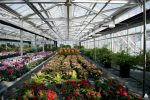What is natural ventilation
Ventilation is the exchange of air inside the greenhouse with air taken from outside the greenhouse using either natural or forced methods. Ventilation efficiency is critical in successful crop growth. The most common problem encountered in hot arid climates is to cool a greenhouses down in comparison with Northern Europe where greenhouses need to be heated. That is the reason why many greenhouse designs from Northern Europe do not work in hot climates climates. Greenhouses designed for arid regions will also differ from those that are designed for humid regions since the parameters that determine how to achieve the same results are quite different.
Ventilation should not be confused with various greenhouse and cold room cooling methods. Although the results are similar, designing a greenhouse with a good ventilation system is quite different from designing a cooling system. Any cooling system in the greenhouse will not operate efficiently with a poorly ventilated greenhouse.
There are two basic methods of ventilation; natural or static ventilation and forced ventilation. Natural ventilation is the process of air renewal in the absence of fans. The driving force behind natural ventilation is the combination of buoyancy of the air inside the greenhouse and wind effects outside the greenhouse. Both factors are influenced by inside and outside temperatures.



